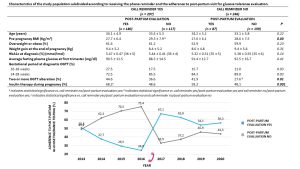Background: Gestational diabetes mellitus (GDM) increases the risk of developing impaired glucose tolerance after delivery. The risk for type 2 diabetes (T2D) ranges from 2 to 70% depending on the studied population and the follow-up duration. Early identification of diabetes is crucial to avoiding the short and long-term consequences of unrecognized diabetes, maintaining women’s health and reducing healthcare costs. Nevertheless, the adherence rate to the recommended post-partum oral glucose tolerance test (OGTT) remains unsatisfactory, being below 50%. Aim: To assess the effectiveness of a phone reminder to improve adherence to post-partum glucose tolerance testing in women with GDM and to identify clinical predictors of adherence to post-partum follow-up. Methods: Retrospective study including 543 women with GDM. We assessed the adherence rate to post-partum OGTT in women who received a phone reminder (n=297) compared to women not alerted (n=246). Demographic and clinical variables were collected to identify the predictors of adherence to the post-partum OGTT. Results: The mean age at pregnancy OGTT was 33.7±5.3 years, and most of women (59.3%) were overweight or obese before pregnancy (BMI 28.2±7.0 kg/m2). The adherence to post-partum OGTT was higher in women who received the phone reminder compared to those not alerted (60.6% vs 35.4%, p<0.001). Women less compliant than those more compliant had a higher pre-pregnancy body mass index (BMI) (29.3±7.9 vs 27.0±6.1 kg/m2, p=0.03). The adherence was lower in pre-pregnant obese compared to non-obese women (42.7% vs 52.0%, p<0.05), in women with only one, compared to multiple OGTT alterations during pregnancy (44.5% vs 57.8%, p<0.05), and in women non-insulin treated compared to those insulin-treated (40.0% vs 57.1% vs, p<0.001). Conclusions: The phone reminder improved post-partum follow-up adherence. Pre-pregnancy BMI, number of OGTT alterations and type of therapy could identify poorly adherent women. Further strategies are needed to prevent these at-risk women from escaping follow-up.


